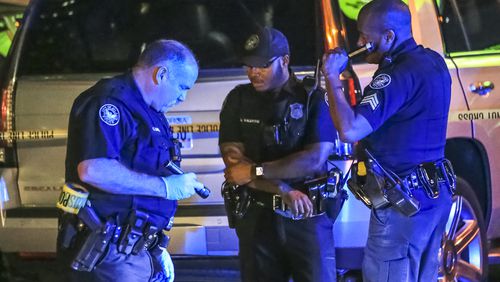Every now and then, I will look up from the keyboard and suddenly realize that I'm in an argument. If you're married, the same thing has probably happened to you once or twice.
Some days ago, I focused on a joint press release on gang activity issued by Brian Kemp and Chris Carr, the Republican candidates for governor and attorney general, respectively.
I didn’t deny the existence of gangs or the crimes they commit. Georgia has some very dark corners. But I confess to throwing some shade at one of their statistics. “According to law enforcement,” the two candidates said, “Georgia has 71,000 gang members and over 1,500 suspected gang networks statewide.”
Seventy-one thousand is a big number, I noted. The Georgia National Guard musters in the neighborhood of 11,000 citizen-soldiers. At the close of the Civil War, the Army of the Potomac under Ulysses Grant stood at about 61,000 men. Robert E. Lee commanded 31,000.
By the above estimation, if gangs were a school system in Georgia, they would be one of the largest in the state, right under Fulton County and its student population of 96,000. The entire student population in the city of Atlanta is only about 51,000.
So 71,000 is a figure that needs to explain itself, I wrote. And then I walked away from the topic. But Brian Kemp did not. Or could not.
On Wednesday, my musings became part of Kemp’s campaign literature. I give them points for including my best line: “We understand the need to be alert, but we also know that inflated numbers can lead to fear, and that fear is often considered a useful tool in political seasons.” This is especially true if most gang members are described as black or Hispanic.
Otherwise, Kemp and his minions were unimpressed. “We need reporters who are going to print the facts without tripping over their bias,” the candidate for governor was quoted as saying. “By giving readers the raw numbers — even if that affirms the legitimacy of a candidate’s policy proposal — members of the media could save lives.”
So let’s dive into gang population figures.
In 2011, the FBI issued a national estimate of 1.4 million gang members on American streets or in American prisons. In Georgia, the FBI estimated, there were between 19,000 to 39,000. Which would imply an increase of at least 82 percent in the last eight years. Gov. Nathan Deal might have something to say about that.
But there’s a catch. The nation’s top law enforcement agency said that its 2011 numbers were not to be trusted: “The FBI and the [National Gang Intelligence Center] do not recommend that jurisdictions use the estimated gang membership totals as exact counts for the numbers of gang members.”
The FBI has not attempted a gang population estimate since. We asked why, but haven’t received an answer yet. Another oversight group, the National Gang Center, stopped issuing similar estimates in 2012. A spokesperson this week cited a lack of funding.
But there may be another reason. “There’s no systemic way of identifying gang members, and there’s no way to know for sure if the officers that are putting that research together are using accurate numbers or estimating off the tops of their heads,” said Jeff Asher, a crime analyst and consultant based in New Orleans. “Even on the neighborhood-to-neighborhood, city-to-city level, it’s really hard to count. When you get up to a state level, it’s virtually impossible to have anything like an accurate count.”
And Georgia’s figure? “If you said 71,000, plus or minus 30,000, that might be a good number,” Asher said.
When the FBI dropped its gang population estimates, several states picked up that gauntlet. Texas was one. Last year, with a population of 28 million, nearly three times that of Georgia, law enforcement agencies in that state put their gang population at a round 100,000.
In Georgia, responsibility for counting gang-bangers was assumed up by the Georgia Gang Investigators Association. “We took it upon ourselves as an association to take on this monumental task just for Georgia, because we didn’t have data from the feds,” said GGIA president Jimmy Callaway, who is also the police chief of the city of Morrow.
In May, the GGIA reported that Georgia had a gang population of 71,000 – an event duly reported by the Journal-Constitution.
Last week, I asked Callaway how that number was assembled. It started with a hard count of 27,000 gang members within the state’s prison population of 52,000. Behind bars, in other words. Added to that is a count from the state Department of Juvenile Justice. Both systems have an interest in keeping members of rival gangs away from each other, so this makes sense.
Surveys were sent out to every law enforcement agency in the state, Callaway said. Most replied with data, but some didn’t. “So we drilled down even further and went to our members,” Callaway said. GGIA numbers about 1,400 cops, deputies, sheriffs and prosecutors.
Callaway said duplicate observations were eliminated. He considers 71,000 to be a hard number, not an estimate.
“To be honest, 71,000 is a lower number than it should be. Because a lot of agencies never got back to us with any data,” he said. “We would never in a million years put out exaggerated numbers to bolster our association or cause further fear.”
The issue is an important one in Georgia’s race for attorney general, in which Republican incumbent Chris Carr faces Democrat Charlie Bailey, a former Fulton County assistant district attorney who specialized in gang prosecution.
Carr, appointed two years ago to fill out the term of a departing Sam Olens, wasn’t eager to get into an argument over numbers. “I trust the prosecutors and law enforcement agencies that have provided a validated estimate of gang activity in their communities. But, whether gang numbers are 71,000 or 91,000 misses the point,” Carr said in an emailed statement. “We can’t talk about human trafficking, drug trafficking and violent crime without admitting we have a gang problem.”
I was able to get Bailey on the phone. He wouldn’t dispute the GGIA numbers, either. (Law enforcement endorsements are just as important to Bailey as they are to Carr.)
But I asked the Democrat what number he used on the stump when quantifying Georgia’s gang population. “I don’t give a number,” Bailey said. “I think the tone of how we talk about it is more important.”
As for me, I still have my doubts. I am content to concede that Jimmy Callaway and his associates have produced a number that they believe in. But I would offer the same suggestion that Mr. Tillerson, one of the greatest algebra teachers in the history of high schools, drilled into me and my peers: Show your work.
Newspapers and other media outlets have learned this the hard way. With every poll we publish, with every data-heavy investigation, we now show our work.
Numbers, especially the important ones, aren’t just destinations to be arrived at. How you get there is every bit as important, and the only way to ensure confidence that the objective is the right one.
About the Author








